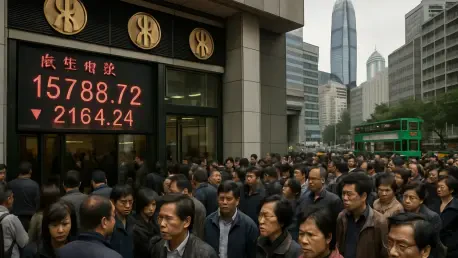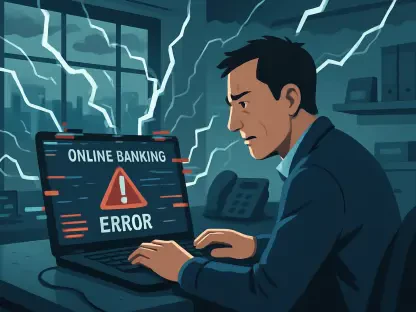Hong Kong, long celebrated as a bustling global financial hub, is now grappling with a deepening crisis in its commercial real estate (CRE) market that threatens to destabilize its banking sector. Skyrocketing vacancy rates, plummeting rents, and a wave of debt-laden developers unable to refinance are creating a perfect storm, with major institutions like HSBC and Hang Seng Bank caught in the crosshairs. The situation has escalated to the point where impaired loans are surging, and the risk of a broader credit crunch looms ominously over the city’s economy. This isn’t just a real estate problem; it’s a financial tightrope walk, as banks face unprecedented exposure to a sector buckling under structural weaknesses. Beyond the immediate challenges, the crisis raises critical questions about systemic resilience and the future of Hong Kong’s economic landscape. Delving into the heart of this turmoil reveals not only the scale of the threat to financial institutions but also the potential pathways to navigate through the chaos.
Unraveling the Real Estate Downturn
The CRE market in Hong Kong is under siege, battered by a toxic combination of oversupply, declining demand, and crushing debt burdens on developers. Smaller and mid-sized firms, often over-leveraged, are finding themselves in dire straits as refinancing options evaporate amidst a market where office and retail spaces sit empty. Prime office rents have nosedived by more than 20% since a few years ago, with vacancy rates climbing to a staggering 19%. In less desirable areas like Kowloon East, the situation is even grimmer, with vacancies soaring higher and property values taking a sharper hit. This structural imbalance—too many buildings and too few tenants—has left developers struggling to meet loan obligations, creating a ripple effect that directly pressures the banks holding these loans. The fallout from this demand slump is not just a statistic; it represents a fundamental challenge to the financial stability of an industry once seen as a cornerstone of Hong Kong’s prosperity.
Compounding the issue is the persistent shift in workplace dynamics and consumer behavior that continues to erode demand for traditional commercial spaces. The rise of remote work, coupled with a shrinking retail sector as e-commerce dominates, has drastically reduced the need for physical office and storefront locations. Even in prime districts, landlords are slashing rents to attract tenants, yet many properties remain unoccupied, further devaluing assets. For banks, this translates into a growing portfolio of loans tied to properties that are rapidly losing worth, raising concerns about collateral adequacy. Developers, particularly those without the financial buffers of larger conglomerates, face liquidity crunches that threaten defaults, putting additional strain on lenders already navigating a precarious economic environment. This evolving landscape underscores the urgency for financial institutions to reassess their exposure to a sector that shows little sign of immediate recovery.
Financial Institutions Under Pressure
Major banks in Hong Kong are bearing the brunt of the real estate crisis, with loan quality deteriorating at an alarming rate. HSBC, a titan in the region, has reported that 73% of its local loans are now classified as impaired or at elevated risk, a sharp increase from under 30% in the prior year. Its subsidiary, Hang Seng Bank, faces an even starker reality, with a non-performing loan (NPL) ratio of 6.7%, marking the highest level since the Asian financial crisis of the late 1990s. With over 36% of its portfolio tied to CRE—well above the average for the city’s key domestic banks—Hang Seng’s vulnerability is starkly evident. While larger institutions like HSBC benefit from diversified holdings and stronger collateral backing, smaller banks lack such cushions, often tied to less resilient developers and lower-tier properties. This disparity in risk exposure highlights a critical divide within the banking sector as the crisis deepens.
The mounting impaired loans are not merely numbers on a balance sheet; they signal a profound erosion of confidence in the real estate sector’s ability to rebound swiftly. For banks, the challenge lies in managing these troubled assets while maintaining liquidity and meeting regulatory capital requirements. Smaller lenders, with less diversified portfolios, are particularly at risk of being overwhelmed if defaults spike further, as their reliance on non-prime properties offers little buffer against falling valuations. Even for giants like HSBC, the sheer scale of exposure means that sustained losses could dent profitability and investor trust. The situation is a stark reminder of how interconnected the health of the CRE market is with the stability of the financial system, pushing banks to adopt more conservative lending practices and scrutinize their risk models. As the pressure builds, the ability of these institutions to weather the storm will depend on both internal strategies and external market dynamics.
Systemic Risks on the Horizon
Beyond the immediate impact on individual banks, the real estate crisis poses a severe threat to Hong Kong’s broader financial ecosystem. A significant wave of short-term debt maturities is set to hit developers between now and 2026, and with refinancing options scarce, the likelihood of widespread defaults is growing. Rising loan-to-value (LTV) ratios, currently averaging between 50% and 55%, are further eroding the value of collateral backing these loans, directly impacting banks’ balance sheets. If property valuations continue their downward spiral, the risk of a full-blown credit crunch becomes a tangible possibility, as lenders may tighten credit availability to protect themselves. Such a scenario would not only exacerbate the struggles of developers but also stifle economic activity across sectors, amplifying financial stress throughout the city and raising alarms about the durability of smaller financial institutions in particular.
The cascading effects of this crisis could reverberate far beyond real estate and banking, potentially destabilizing confidence in Hong Kong’s economic framework. Analysts have cautioned that continuous property devaluations could trigger a vicious cycle, where banks, facing shrinking collateral values, become increasingly reluctant to lend, further choking off capital for developers and other businesses. This tightening of credit could hinder recovery efforts, prolonging the downturn and affecting employment and investment in the region. The interconnected nature of global finance means that any significant disruption in Hong Kong—a key international hub—could have wider implications, prompting scrutiny from international regulators and investors. Addressing these systemic risks requires not just reactive measures from banks but also proactive policy interventions to stabilize the market before the situation spirals further out of control.
Navigating the Crisis with Strategic Moves
For investors and financial stakeholders, the current turmoil in Hong Kong’s real estate market presents a complex blend of peril and possibility. Hedging against bank exposure through financial instruments like credit default swaps has emerged as a prudent tactic to mitigate potential losses tied to loan defaults. Simultaneously, some savvy players are targeting distressed assets, seeing potential in repurposing underutilized commercial spaces—such as converting vacant offices into student housing under government-supported initiatives. Diversification into more stable sectors, like industrial real estate and data centers, is also gaining momentum as a way to balance portfolios against the volatility of traditional CRE. Keeping a close watch on evolving government policies is equally vital, as regulatory or fiscal measures could provide much-needed relief to the market and signal turning points for recovery.
While risks dominate the immediate landscape, strategic positioning can uncover opportunities for those willing to navigate the uncertainty. Acquiring undervalued properties at a discount, particularly in areas with long-term growth potential, offers a pathway for future gains if market conditions stabilize. Banks, too, are recalibrating their approaches, tightening lending criteria and bolstering risk management frameworks to shield against further deterioration. Collaboration between public and private sectors could play a pivotal role, especially if government programs incentivize adaptive reuse or infrastructure development that revitalizes demand. The key for all stakeholders lies in balancing short-term caution with a long-term vision, recognizing that while the crisis is acute, disciplined capital allocation and patience could yield significant returns as the market eventually recalibrates to new economic realities.
Building Resilience for the Future
Despite the dark clouds hanging over Hong Kong’s CRE sector, there remains a foundation for cautious optimism rooted in the city’s enduring status as a global financial powerhouse. Government efforts, such as ambitious plans to develop 440,000 housing units over the coming decade and pilot programs to repurpose commercial spaces, offer glimmers of hope for stabilizing the market. These initiatives suggest a commitment to addressing structural imbalances, potentially easing the burden on developers and, by extension, the banks financing them. While the near-term outlook remains challenging, with persistent demand weaknesses and financial strain, the belief in Hong Kong’s long-term resilience underpins a narrative of eventual recovery. This inherent strength provides a bedrock for stakeholders to build upon, even as they brace for continued volatility in the immediate future.
Looking back, the response to this crisis highlighted the importance of adaptability and foresight in managing financial exposure. Banks that tightened their lending practices early and diversified their portfolios weathered the storm better than those overly reliant on CRE loans. Investors who seized opportunities in distressed assets or pivoted to resilient sectors like logistics also found ways to mitigate losses. Moving forward, the focus should shift to strengthening risk assessment models and fostering closer collaboration with policymakers to anticipate future shocks. Enhancing transparency in loan portfolios and prioritizing sustainable development projects can further safeguard against similar downturns. As Hong Kong’s financial sector reflects on these challenges, the lessons learned must guide strategic planning, ensuring that both banks and investors are better equipped to navigate uncertainties and capitalize on the city’s fundamental economic strengths.









